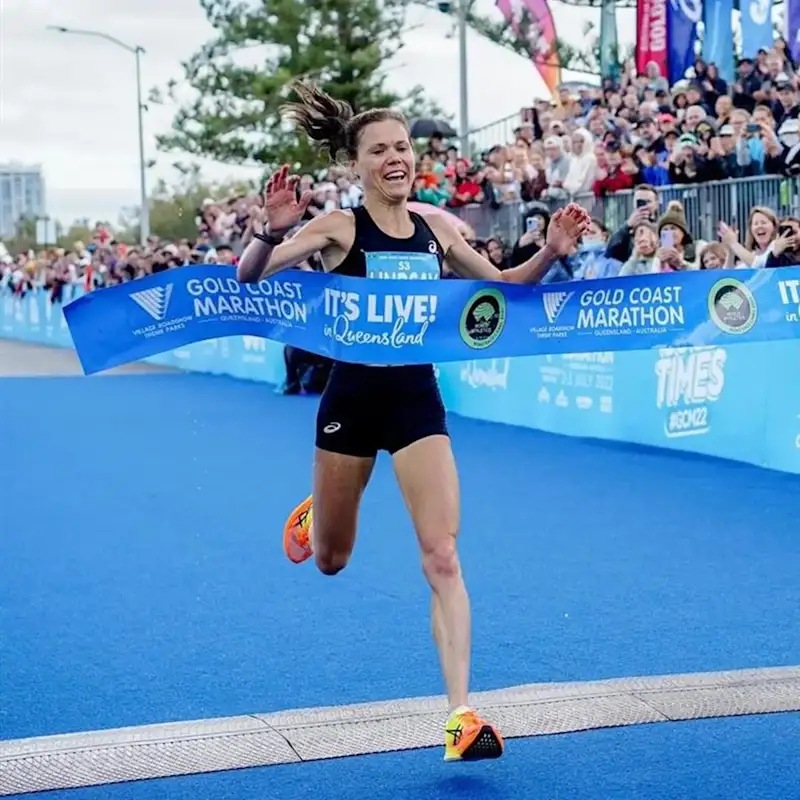
Lindsay Flanagan
Chicago Marathon
Lindsay's headline numbers
Lindsay's strategy
Fueling
Carbohydrate is the main fuel you burn when racing. Failing to fuel properly is a leading cause of underperformance in longer races.
Going into the race, Lindsay felt confident in her fueling strategy given she had practised it during all of her hard, long sessions. In addition to bolstering her trust in the plan, this gut training will also have increased Lindsay’s tolerance of consuming this amount of carbohydrate whilst working at such high relative intensities, especially important as she was out of practise due to an injury for a large part of the year. There is vast evidence showing higher carbohydrate intakes, >60g/h, correlated with improved marathon performance but it’s still common to see runners underfuel reportedly due to the risk of GI issues. Looking at Lindsay’s numbers, she still has room to optimise her intake further by finishing both her pre-race and first in race PF 30 Gel, and with continued regular gut training the risk of GI discomfort can be reduced.
Hydration
Taking on board an appropriate amount of fluid and sodium is essential to maintaining blood volume and supporting the cardiovascular effort needed to perform on race day.
Whilst the absolute amount of sodium and fluid consumed per hour is important, it’s critical to consider these in relation to each other. This is known as 'relative sodium concentration' and it’s expressed in milligrams per litre (mg/L). How much sodium you’re taking in per litre of fluid is more important than the absolute amount taken in per hour.
Sweat sodium concentration (mg/L) is largely genetically determined and remains relatively stable. Knowing how salty your sweat is enables you to replace a good proportion of your sweat losses, which can range from 200-2,000mg/L.
Whilst Lindsay’s losses are on the low side, getting her hydration strategy right is still important if she wants to perform at her best.
Learn moreAs an experienced marathon runner and having undertaken some sweat rate testing in the past, Lindsay has a good understanding of her fluid needs and the amount of dehydration she can tolerate. With the expected mild conditions, Lindsay reduced the volume in each of her seven pro aid station bottles to ~180ml compared to ~230ml in her pre-injury races, which she felt met her needs effectively on race day. By adding one scoop of PF Carb & Electrolyte Drink Mix to the lower amount of water in each bottle, she slightly over concentrated them and took on a relative sodium concentration much higher than her losses. Though this came at no detriment to Lindsay, she should look to incorporate some bottles of PF Carb Only Drink Mix within the strategy next time out to increase her carb intake but keep the concentration of electrolytes closer to her moderate sweat losses.
Caffeine
Beyond the Three Levers of Performance (carb, sodium and fluid), caffeine is one of only a few substances that is proven to improve performance for most endurance athletes as it can help stave off mental and physical fatigue.
Lindsay stuck to the ‘original’ PF 30 Gels before and during the marathon, having not tried out PF 30 Caffeine Gels previously. But, with plenty of evidence to show the added performance gains that caffeine has to offer, such as increasing focus and perceived energy levels, Lindsay should incorporate a few Caffeine Gels in her training to see if the stimulant works well for her and is something she could utilise in her next race.
How Lindsay hit her numbers
Here's everything that Lindsay ate and drank on the day...
Lindsay's weapons of choice
Final thoughts
Lindsay's full stats
Data Confidence?
There is good confidence in the accuracy of the data reported. An athlete feels that the numbers closely reflect what they consumed despite a couple of estimations which may carry some degree of error. The majority of what was consumed is recorded to a high level of specificity (most volumes are known through the use of bottles brands quantities flavours). The numbers are very plausible and align with previous data recordings (if an athlete has collected data previously).